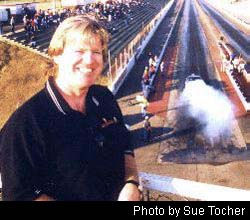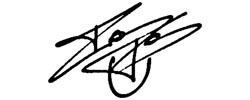
Safety First – For Everyone
11/8/06

 o doubt, when bracket racer Steve Johnson walked to the starting line at Phenix City (AL) Dragway to watch his daughter race her rear-engined dragster, her safety was in his mind. Certainly he wanted her to drive well, win the round and then they’d all go back to the pits to prepare for the next race, but I’m sure he also looked over her tires for wear and damage, checked her seatbelts, and made sure her chute was packed and ready to go. He probably gave little thought to the risk he might be taking in going out there.
o doubt, when bracket racer Steve Johnson walked to the starting line at Phenix City (AL) Dragway to watch his daughter race her rear-engined dragster, her safety was in his mind. Certainly he wanted her to drive well, win the round and then they’d all go back to the pits to prepare for the next race, but I’m sure he also looked over her tires for wear and damage, checked her seatbelts, and made sure her chute was packed and ready to go. He probably gave little thought to the risk he might be taking in going out there.
Tragically, Steve Johnson is lying in a hospital now, not having even opened his eyes since being run over by that dragster’s rear tire a couple of weeks ago. Apparently, the car’s transbrake didn't hold as the tree came down so Johnson’s daughter stopped the car and he stepped in from the side to check things out. Not seeing him, however, she hit the gas when the light turned green and Johnson was steamrolled by the rear slick, sustaining a broken ankle, punctured lung, internal bruising and serious head injuries.
In an instant what began as just another routine run was altered by one bad decision, tossing a family into upheaval, placing tremendous strain on their resources, and worst of all leaving a man fighting for his life.
Not for a moment am I saying Johnson did anything “wrong” in going to his daughter’s aid, just that he made a decision with dire consequences. Any one of us could’ve made a similar choice, but that doesn’t diminish the lack of situational awareness that led to the accident. And Johnson surely knows, intellectually at least, that being near a running racecar is always potentially dangerous, but familiarity breeds not only contempt, but complacency. And that’s what we must guard against.
We see it all the time: crewmembers poised like matadors in front of cars performing burnouts, racers crawling under cars supported only by a hydraulic jack for last-minute tweaks, track workers and crewmembers standing directly behind cars doing burnouts. Watch for long enough and the list of casual, careless risks that people take at the track can be a long one.
Some of this may be remedied by track and sanctioning body enforcement, but really, it’s personal responsibility that will make a difference. Only you can look out for your safety 100 percent of the time and that obviously requires unending vigilance, particularly on a “hot” track. That means taking simple steps like never standing behind a burnout, where those spinning tires can fling back tiny rocks, nuts, or other debris at near bullet-like speeds. I recall one story of a car running over part of its own header that fell off during a burnout, slinging the part backwards into a bystander and breaking his leg.
Likewise, it should go without saying that jackstands are non-optional when going under a car. But how about during pit warm-ups, when I often see cars with spinning rear tires held aloft only by a single jack under the rearend while crew chief and assorted helpers and observers are bent over the engine compartment. If that jack fails—even with someone in the driver’s seat—in the typically tight confines of a working pit there’s surely going to be injuries, if not worse.
And for the life of me I cannot understand why some guys feel it’s absolutely necessary to stand in the middle of the lane to the last possible second as a several-thousand-horsepower racecar bears down on them with smoke boiling from the rear tires. The worst is when they stand their ground as their driver brings the car to a halt just inches from their legs. I assume they view the process as an intricate dance of man and machine, a demonstration of trust and skill choreographed through countless practices.
They’re out there making elaborate hand gestures to make sure their guy keeps it straight, but really, if he can’t keep it in the groove on his own during a burnout is it really going to matter in the long run? Watch the pro ranks and tell me if that goes on there. To me, and to several veteran racers I’ve mentioned this to, this places the crewmember in completely unnecessary danger if a throttle sticks, the brakes fail, or the driver just makes a big mistake. Why take the chance?
Then there’s the blatant risk taking that often comes late on Saturday night, long after qualifying is completed and the racecars are safely tucked away, when crewmembers break out the quads and golf carts for a little unsanctioned racing or wheelie action. Now I’ll admit to enjoying watching these antics as much as the next guy, but there’s always that niggling thought in the back of my mind that it’s always an accident that just hasn’t happened yet.
Just ask Champ Car star Paul Tracy, who recently broke his right scapula while trying to jump sand dunes with a golf cart! "Sorry to say it was self-inflicted. I was at a party and had had a little too much to drink, and we thought it was a good idea to go out on a golf-cart and try and jump sand dunes with it,” Tracy said last week. “We were wrong. It wasn't a good idea.”
No kidding.
Now, before anyone accuses me of getting on a high horse, allow me to confess I count myself among those who sometimes get a little too comfortable in my surroundings. While I’ve never had what I consider a “close call” at the drag strip, I know my guard has been down at times when just a slight shift in circumstances could’ve put me in serious harm’s way. I think anyone who’s honest with him or her self could point to similar moments.
The fact is, Johnson’s accident reminded me that danger isn’t limited to between the guardwalls at speed. All of us frequent visitors to trackside—drivers, crewmembers, track and sanctioning body officials, manufacturer’s reps, and yes, writers and photographers—need to take care and retain our situational awareness. I just thought I should remind you, too. ![]()
Race safe,
P.S. Steve Johnson is self employed and married with two daughters, but unfortunately carried no health insurance (yet another cautionary tale). Checks to help the Johnson family (payable to Bonnie Johnson) can be sent to Wade Mooney, 5 Chestnut St., Phenix City, AL 36869, or donations can be made via Paypal to gingermoon02@yahoo.com.
|
|
